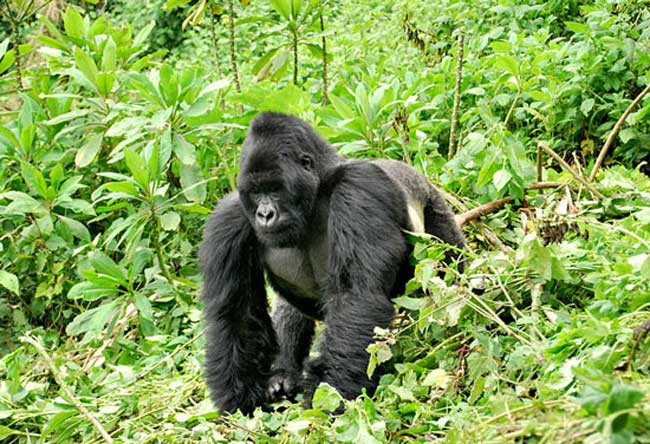
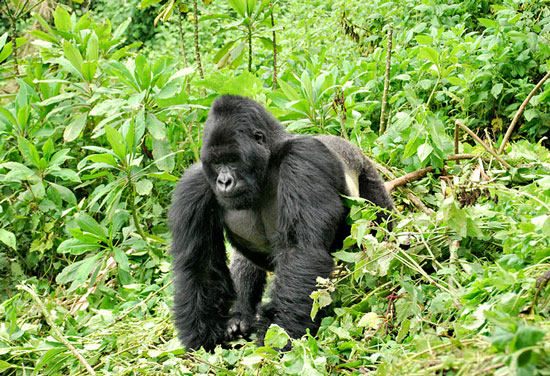
After several hours following paths through the trees, Wilbur took a message on his radio, paused to unsheathe his machete, and veered from the path to hack through the thick scrub of Uganda’s Bwindi Impenetrable Forest.
We had little option but to follow, as I finally understood why the jungle had got its name. We had come in search of the mountain gorilla, and Wilbur had just received word that we were close.
Fewer than a thousand mountain gorillas remain in the world, inhabiting a thin strip of territory stretching across Uganda, Rwanda and Democratic Republic of Congo (DRC).
The survival of one of our most iconic relatives is precariously balanced.
Gorilla Trek
The opportunity to trek the East African mountains in search of the gorilla is the privilege of the very few, and consequently one of the world’s ultimate ecotourism experiences.
Each of the few dozen permits available each day across the region costs $500. This allows you one hour with the gorillas, should you find them at all.
In dollars-per-minute terms, this is probably the single most expensive activity I will ever undertake.
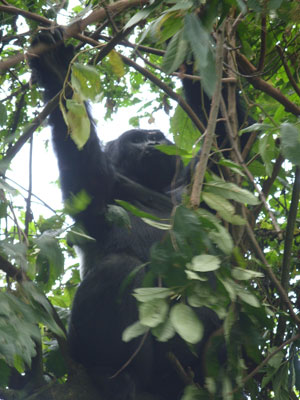
The gorillas are a big tourist draw, but the hefty price tag plays a crucial role in restricting the number of visitors who come to this remote corner of the Rift Valley in search of their own ‘David Attenborough moment’.
This octogenarian British broadcaster famously recorded a calm and professional to-camera piece, while being groomed by an enormous gorilla directly behind him.
The permits and the attendant tourism also generate vital income for local communities, helping to ensure their essential support for conservation.
The Popular Place: Rwanda
Rwanda is a popular place to trek the gorillas. Permits are also available over the border in DRC, but groups tend to stay in Uganda or Rwanda and take a hurried day trip over the border.
Most popular is Uganda, closer to the region’s hub at Nairobi, offering two separate gorilla national parks: Mgahinga and Bwindi. But there is far more to Uganda than just the gorillas.
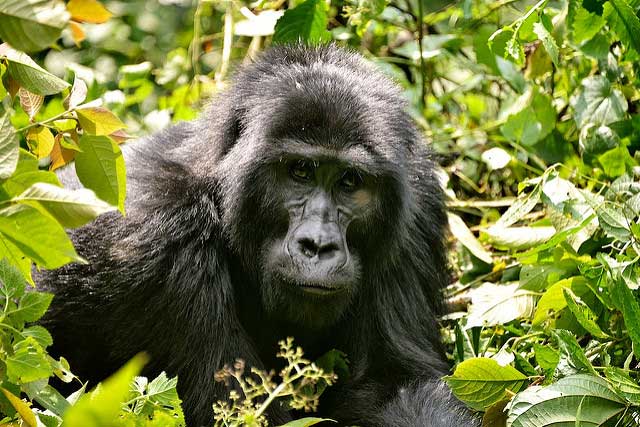
Kampala, the dusty capital, offers little for the passing tourist, bar a chance to stock up on necessities at the shopping malls and markets.
But out in the beautiful countryside, you will pass fields of sorghum, corn and bananas in rich, red soil.
Beautiful Lake Bunyoni
At road-side truck stops you can fight the crowds for barbecued skewers of meat and corn on the cob swimming in grease, salt and flavour.
Beautiful Lake Bunyoni’s glass-like water perfectly mirrors an empty, cloudless sky.
Boat trips on the lake in the early morning are peaceful, with it ringed by an ethereal mist. We spent long, lazy days on the lake shore swimming in the cool waters.
Hiring a dugout canoe, we paddled frustratingly in circles.
We finally mastered the frustrating art of ordering of food at Ugandan restaurants by placing our orders a full two hours before we wanted to eat.
The Adventure Sports Capital: Uganda
But Uganda is justifiably famous as an adventure sports capital. Jinja, sitting at the source of the Nile at Lake Victoria, is kitted out for the adrenaline rush.
Although somewhat diminished following the completion of a dam, this remains one of the premier whitewater destinations in the world, and running the Nile rapids in rafts or kayaks is still the most popular pastime.
The really crazy can dispense with a boat altogether and brave the rapids with flippers and a body board.
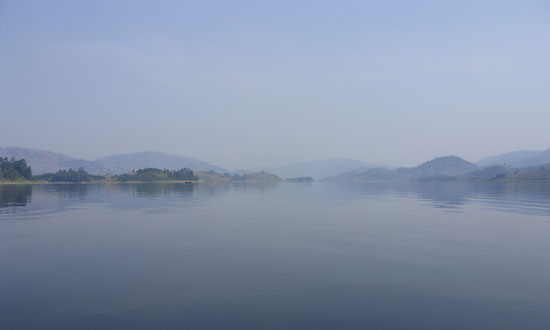
At Jinja, a new arrival on the adventure scene is jet boating. An enterprising Kiwi powers tourists up and down the river at high speed, demonstrating the craft’s agility by turning it on a penny, and its power by driving it up small rapids.
Back on terra firma you can take a quad bike tour through the surrounding countryside, going off road, over jumps, and stopping in villages.
But it was after a long, pre-dawn drive into the highlands from our base at Kabale that I embarked upon the activity that had really brought me to this part of the world.
Our Guide
We were introduced to our guide, Wilbur, and armed guard. I still don’t know whether he was guarding the wildlife from us, us from the wildlife, or us all from another type of guerrilla altogether.
The going was initially easy, following small paths through the undergrowth, and we had trudged for several hours before Wilbur had drawn his machete.
It is a professional operation with spotters sent out in the early morning to locate the gorilla groups, before radioing back to guide the tourists in.
In the midst of the jungle, entirely surrounded by identical-looking trees, I could only guess at how they navigated.
The trek is only recommended for the fit and healthy, amply underlined as we fought our way into the unrelenting bush.
At the briefing, it had been pointed out that in the event of incapacity the only means of rescue would be by stretcher, or as the guides had nicknamed it — African helicopter.
It was hot, and the undergrowth was thick. Twigs and thorns tore at our legs and leaves and cobwebs lodged in our hair. No amount of DEET would keep the cloud of buzzing pests from my head.
Watching The Gorilla
But all this discomfort was soon forgotten when Wilbur and the guard came sprinting back down the freshly-cut trail towards us. It certainly focuses your attention when the guy with the gun is running scared.
Leading the party, they had rounded a corner and surprised a silverback that sat in a clearing.
So called because their backs sparkle with grey hair as they mature, a full-grown adult male gorilla is a truly awesome sight.
Surprised, this silverback had charged them, leaving Wilbur chattering excitedly about how close he had come to being floored by a swipe at his leg.
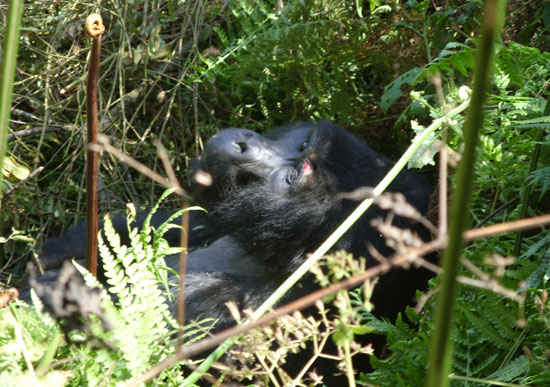
After a suitable pause, it was with more than a little trepidation that we rounded the corner again. But having established his clear dominance over us, the silverback had lost interest.
He had wandered off down the steep valley side, and sat in the long grass, surveying his domain.
He was now so relaxed, we approached within 1.5 meters, crouched precariously on the slope above.
At 200 kilos, he was effortlessly powerful. A fresh cut above his eye, showing bright red against the black hair, betrayed a recent fight and made the animal look even more fearsome.
He stuffed his face constantly, plucking plants and grasses from all around.
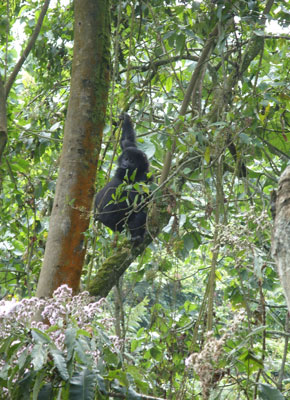
Nearby, a baby gorilla practised climbing in the trees, swinging up and down a sapling. Its mother sat a little farther off, watching from a treetop. The silverback ignored us all.
Before long, he grew tired of his audience, and stalked easily through the bush we worked so laboriously to penetrate.
We followed clumsily, again blazing an awkward trail with the machete, slipping and sliding down into the valley.
He climbed a tree and looked imperiously down at us, pausing only to contemptuously urinate from the treetop.
And then our hour was over. Watching this fascinating primate, such a close cousin in the evolutionary family tree, the time had flown by.
We babbled happily as we fought our way back out of the bush over the next few hours.
It was an incredible experience, but one that hangs in the balance if the critically endangered mountain gorilla loses its fight for survival with man.
If You Go
A popular way to visit the area is by overland truck. These converted British Army lorries carry everything required for life on the road, from tents and stoves to tables and chairs.
Overland operators can also lay their hands on gorilla permits. Different companies offer varying levels of comfort and cheaper options expect you to muck in and pitch tents, cook and clean.
Alex’ trip was organised by Oasis Overland, a company based in Somerset in the UK.
Author Bio: Alex has globe-trotted through over seventy countries in the last decade in search of exciting and interesting challenges. En route, he has caught a train from Bristol to China, sailed 2,500 miles of the Amazon, and been crowned World Tuktuk Racing Champion in India. Alex is a firm believer that even if you are constrained by the commitments of real life, it doesn’t mean you can’t still have an adventure. After all, he’s an accountant.
- 6 Reasons to Visit Portland, Maine (+ Travel Tips) - April 18, 2024
- Cruising with Discovery Princess on the Mexican Riviera - March 30, 2024
- La Paz, Mexico: Pearl on the Sea of Cortez - February 26, 2024
